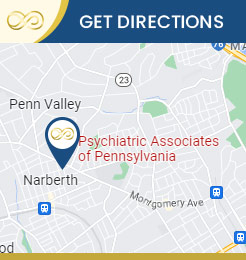Virtual Reality Exposure Therapy on the Main Line of Philadelphia in Narberth PA
Do ever think about: Can Virtual Reality, or VR, help my mental health? What is VR Exposure Therapy? How does VR Exposure Therapy differ from traditional Exposure Therapy? Is VR exposure safe? Can I do VR Exposure Therapy from home? What are the benefits of VR Exposure Therapy? Our experts at Psychiatric Associates of Pennsylvania can help. For more information, contact us or schedule an appointment online. We are conveniently located on the Main Line of Philadelphia, serving patients from Narberth PA, Philadelphia PA, Media PA, King of Prussia PA, Newtown Square PA, Abington PA, Wayne PA, Malvern PA, Plymouth Meeting PA, Ardmore PA, Villanova PA, and surrounding areas.


Table of Contents:
What is exposure therapy?
Why is Exposure Therapy difficult?
What is Virtual Reality Exposure Therapy?
What are the benefits of Virtual Reality Exposure Therapy?
Exposure therapy is a form of psychotherapy that focuses on helping individuals confront and reduce their fear or anxiety by gradually exposing them to the situations or stimuli that trigger their distress. The goal of exposure therapy is to enable individuals to confront their fears in a safe and controlled environment, learn to tolerate the associated anxiety, and ultimately reduce their anxiety response over time.
The underlying principle of exposure therapy is based on the concept of “extinction.” When a person with an anxiety disorder avoids or escapes from situations that provoke fear or anxiety, they miss the opportunity to learn that their fears are irrational or that they can cope with the situation effectively. Exposure therapy aims to break this avoidance cycle by systematically exposing individuals to the feared situations or stimuli. The process of exposure therapy typically involves the following steps:
Assessment: The therapist works with the individual to identify the specific fears or anxiety triggers and assess the severity of their symptoms. This helps in developing a tailored treatment plan.
Creating a fear hierarchy: Together, the therapist and individual create a list, often referred to as a fear hierarchy or anxiety hierarchy, which ranks feared situations or stimuli from least anxiety-provoking to most anxiety-provoking. This hierarchy serves as a guide for gradually exposing the individual to the feared stimuli.
Gradual exposure: The individual is exposed to the feared situations or stimuli in a controlled manner. This exposure can be done in imagination (imaginal exposure) or in real life (in vivo exposure). The exposure may start with less anxiety-inducing situations and progress to more challenging ones over time.
Sustained exposure: The exposure is repeated over multiple sessions, allowing the individual to experience the anxiety associated with the feared stimuli without engaging in avoidance behaviors. Through repeated exposure, the anxiety response gradually diminishes as the individual learns that their feared outcomes do not occur or that they can effectively cope with the situation.
Cognitive restructuring: In conjunction with exposure, the therapist may also help the individual challenge and reframe their negative thoughts or beliefs associated with the feared situations. This cognitive restructuring aims to replace irrational or distorted thoughts with more realistic and adaptive ones.
Exposure therapy has been found to be effective in treating various anxiety disorders, including specific phobias, social anxiety disorder, panic disorder, generalized anxiety disorder, and post-traumatic stress disorder (PTSD). It is often used as a component of cognitive-behavioral therapy (CBT) or other evidence-based treatments.
Although effective, Exposure therapy can be incredibly difficult and at time, it can even make certain anxieties worse and can reinforce avoidant behaviors. When individuals first confront their fears or anxiety-provoking situations, they often experience a surge of intense anxiety and distress. This can be uncomfortable and overwhelming, leading some individuals to resist or avoid exposure altogether. This can then trigger avoidant behaviors which leads to a drop in anxiety. Ultimately, this can reinforce the anxiety cycle and the use of avoidant behaviors as an appropriate solution to avoid the anxiety.
Virtual reality exposure therapy (VRET) involves creating a computer-generated, immersive virtual environment that simulates real-life situations or scenarios that trigger anxiety or fear in an individual. During a VRET session, the individual wears a VR headset and is immersed in a three-dimensional, interactive virtual environment. The virtual environment is designed to closely resemble the anxiety-inducing situations the individual wants to overcome. For example, someone with a fear of heights might be exposed to a virtual scenario where they stand on the edge of a tall building or walk across a narrow bridge. The therapist guides the session, adjusting the intensity and difficulty of the virtual scenarios based on the individual’s progress and comfort level. The individual is encouraged to engage with the virtual environment, facing their fears and practicing coping strategies to manage anxiety. The therapist can also provide real-time feedback and support during the session.
The benefits of VRET include:
Controlled exposure: VRET allows individuals to experience anxiety-provoking situations in a controlled and safe environment, providing a sense of security while gradually exposing them to their fears.
Enhanced engagement and presence: The immersive nature of VR increases the sense of presence and engagement, making the virtual experiences feel more realistic and impactful.
Customizability: VRET can be tailored to the specific needs of each individual, allowing for personalized scenarios and adjustments to the difficulty level of the exposure.
Real-time feedback and monitoring: Therapists can monitor the individual’s physiological and emotional responses during the VR session, gaining insights into their progress and adjusting the therapy accordingly.
Generalization of skills: Through repeated exposure and practice in the virtual environment, individuals can develop and generalize coping skills and strategies to real-life situations outside the therapy setting.
VRET has been successfully used in the treatment of various anxiety disorders, including phobias, post-traumatic stress disorder (PTSD), social anxiety disorder, and obsessive-compulsive disorder (OCD). However, it’s important to note that VRET should be conducted under the guidance of a trained therapist or mental health professional to ensure its effectiveness and safety.


Additional Conditions We Treat
▸ Life Transitions
▸ Depression & Other Mood Disorders
▸ Anxiety Disorders
▸ PTSD & Other Trauma Related Disorders
▸ Obsessive Compulsive Disorders
▸ Attention Deficit and Hyperactivity Disorder (ADHD)
▸ Bipolar Disorders
▸ Eating Disorders
▸ Autism Spectrum Disorders
▸ Psychotic Disorders
▸ Sleep Disorders
▸ Phobia Experts
▸ Gender Dysphoria
▸ LGBTQIA+ Affirmative Therapy
▸ Men’s Mental Health
▸ Women’s Issues
▸ End of Life Mental Health
Additional Services You May Need
▸ Psychiatry and Medication Management
▸ Child and Adolescent Psychiatry
▸ Therapy and Counseling
▸ Treatment Resistant Depression
▸ Treatment Resistant OCD
▸ Smoking Cessation
▸ Transcranial Magnetic Stimulation (TMS)
▸ Psychoeducational Assessments
▸ Eating Disorders Program
▸ Neurofeedback
▸ Neurotechnology
▸ Virtual Reality Exposure Therapy
▸ Genetic Counseling
▸ Preventative Mental Health
▸ Forensic Psychiatry
▸ Anger Management
▸ Cognitive Behavioral Therapy
▸ Couples Counseling
▸ EMDR
▸ Family Therapists
▸ Grief Counselors
▸ Mindfulness and Meditation
▸ Palliative Psychology
▸ Internal Family Systems
▸ Parenting Coach
▸ Executive Mental Health


